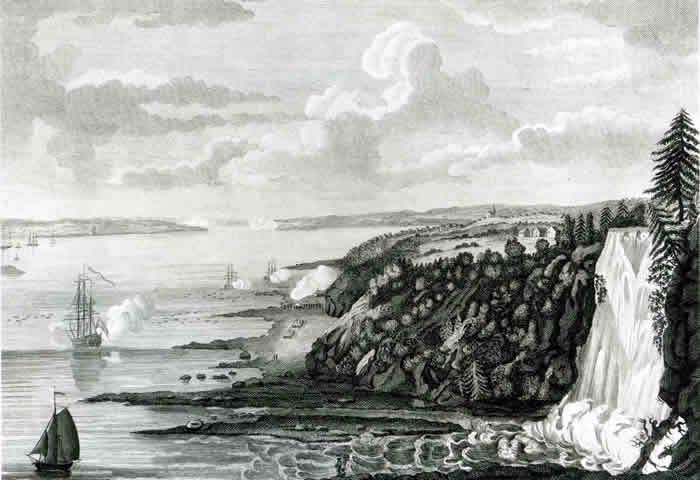

SIEGE OF QUÉBEC
The Montmorency Battle
Course / Assessment
This alarm created a degree of confusion which Wolfe noticed and which led him to make a decision: he had to change his plan and attack. Therefore, he ordered that Townshend and Murray, who were at the Montmorency camp, and Monckton at Pointe-Lévy, prepare themselves. During the afternoon, Monckton's troops were about to land but they were stopped by a barrier of stone blocks that was only visible at low tide. The operation was suspended until the General could decide on a better place to carry out his plan. Around 5:30 p.m., the Grenadiers and the men of the 60th Regiment landed and led the attack. At the same time, Townshend's and Murray's troops forded the river at the bottom of the falls (this was possible only at low tide) and headed west to join Monckton's men who had just landed.

In the meantime, Montcalm followed the British troops' movements. His challenge was to predict their landing place. As the enemy advanced, it became clear that the battle would be waged near Montmorency. Montcalm therefore reinforced his left wing, which was under Lévis' command.
On the British side, the soldiers were feverish: they had been waiting for this for a month now. But this feverishness would be their downfall. The Grenadiers, without waiting for Monckton's men or for Townshend and Murray's men to arrive to back up the operation, attacked enemy lines by preventing the men from escalating the heights to reach their trenches. The French immediately abandoned the redoubt and opened fire99.
The operation was disastrous for the British. In the first place, the slope the Grenadiers had to climb turned out to be steeper that Wolfe and his men expected. Moreover, as if this disturbance was not enough, nature in turn became a spoilsport, which was to the advantage of the French troops. While the French were probably close to an ammunition shortage, a storm burst, making it more difficult, even impossible, for the enemy to climb the steep slope to reach the French lines. Moreover, this ascent was hindered by fire from the infantrymen hiding in the groves. And the Grenadiers' red uniforms were an ideal target100.
In the meantime, the rain was even more damaging since it drenched the gun powder and so put an end to the gunfire. The Grenadiers were forced to turn back and withdraw to the redoubt where the 15th and 78th Regiments had already gone. As for Townshend's men, shortly before the storm, they had attacked the Sault redoubt. Their situation was not any better: the defenders, relatively sheltered from the rain, fired incessantly on their assailants whose progress was held up by the rain101.
Wolfe realized that the attack was a failure. The tide was slowly rising, threatening to cut off Townshend's and Murray's potential retreat. They had to turn back even before they had a chance to rejoin the rest of the army, and again ford across the Montmorency River before it was too late. As for the regiments of the 1st Brigade, including the Grenadiers who were still alive, they left in their boats, except for some of the 78th Regiment which headed for the Montmorency camp, escorting General Wolfe102.
At seven o'clock the storm had ended, and so had the battle of Montmorency. As the sky began to clear and the fog was dispelled, the French could see, from the top of the cliff, the movement of enemy troops beating a retreat. Great cheers sounded: the French had won!
For the British, the end result of the operation was appalling: 200 dead or wounded, including a colonel, 8 captains, 21 lieutenants and 3 ensigns. As for the French army, its casualties amounted to approximately 70 dead and wounded, most of whom had fallen under the fire of British artillery on the east side of the Montmorency River103. However, the French could now breathe more easily since the enemy had been driven back.
